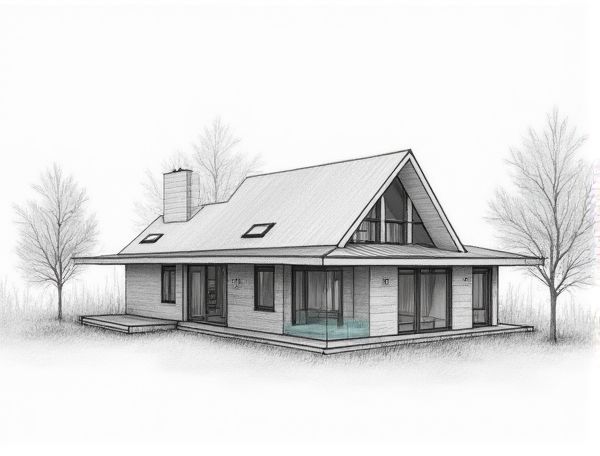
Photo illustration: Passive house home design with mechanical heat recovery ventilation
Passive house home design integrates mechanical heat recovery ventilation to ensure exceptional energy efficiency and superior indoor air quality by continuously exchanging stale indoor air with fresh outdoor air while retaining heat. Discover how this innovative approach can transform Your living space into a sustainable, comfortable haven by reading more in the article.
Introduction to Passive House Design Principles
Passive House design principles emphasize superior insulation, airtight construction, and high-performance windows to minimize energy consumption. This approach relies on maximizing natural heat sources through strategic building orientation and ventilation systems with heat recovery to maintain indoor air quality. Adopting these standards results in homes with significantly reduced heating and cooling needs, promoting sustainability and occupant comfort.
The Role of Mechanical Heat Recovery Ventilation (MVHR)
Mechanical Heat Recovery Ventilation (MVHR) plays a crucial role in enhancing indoor air quality by continuously exchanging stale indoor air with fresh outdoor air while recovering up to 90% of the heat from outgoing air. This energy-efficient system reduces heating costs and minimizes heat loss, making it essential for sustainable and passive home designs. MVHR systems also help control humidity levels, prevent condensation, and improve overall comfort in modern, airtight homes.
Key Benefits of Passive Houses with MVHR Systems
Passive houses equipped with Mechanical Ventilation with Heat Recovery (MVHR) systems significantly reduce energy consumption by maintaining consistent indoor temperatures and recycling heat from exhausted air. These systems improve indoor air quality by continuously filtering air and reducing humidity, leading to healthier living environments. Enhanced airtightness combined with MVHR technology minimizes drafts and energy loss, resulting in lower utility bills and increased long-term sustainability.
Essential Design Strategies for Passive Homes
Maximizing energy efficiency in passive homes requires strategic insulation, airtight construction, and high-performance windows to minimize heat loss. Orientation of the building to optimize solar gain ensures natural heating and lighting throughout the year. Incorporating ventilation systems with heat recovery balances indoor air quality while retaining warmth, reducing overall energy consumption.
Building Envelope: Insulation and Airtightness
Effective building envelope design prioritizes high-performance insulation materials such as spray foam, rigid foam boards, and mineral wool to minimize thermal bridging and enhance energy efficiency. Achieving airtightness through meticulous sealing of gaps, joints, and penetrations significantly reduces air leakage, improving indoor comfort and lowering heating and cooling costs.
Selecting and Sizing an MVHR Unit
Selecting and sizing an MVHR unit requires careful calculation of your home's volume and air change rates to ensure optimal indoor air quality and energy efficiency. Properly sized units prevent excessive noise and energy waste, while maintaining balanced ventilation tailored to your specific home design.
Optimizing Indoor Air Quality and Comfort
Optimizing indoor air quality and comfort involves selecting high-performance air filtration systems and incorporating natural ventilation strategies that reduce pollutants and maintain consistent temperature and humidity levels. Your home design should integrate energy-efficient HVAC units and moisture control solutions to create a healthy living environment that supports well-being and productivity.
Energy Efficiency and Cost Savings
Incorporating energy-efficient windows, LED lighting, and high-performance insulation significantly reduces utility bills while enhancing indoor comfort. Utilizing smart thermostats and solar panels optimizes energy consumption, leading to substantial long-term cost savings. Designing homes with passive solar principles and proper ventilation further minimizes energy waste and lowers heating and cooling expenses.
Common Challenges and Solutions in Passive House Projects
Achieving airtightness and continuous insulation remain common challenges in Passive House projects, often requiring meticulous detailing and high-quality materials to prevent thermal bridging. Ensuring proper ventilation with heat recovery systems addresses indoor air quality without compromising energy efficiency. Early collaboration among architects, builders, and engineers facilitates problem-solving and adherence to rigorous Passive House standards.
Future Trends in Passive House and MVHR Integration
Future trends in passive house design emphasize enhanced integration of Mechanical Ventilation with Heat Recovery (MVHR) systems to optimize energy efficiency and indoor air quality. Advances in smart technology enable real-time monitoring and adaptive controls, improving thermal comfort while reducing energy consumption. The use of eco-friendly materials coupled with airtight construction standards further supports sustainable living environments aligned with future regulatory frameworks.
 homedesy.com
homedesy.com